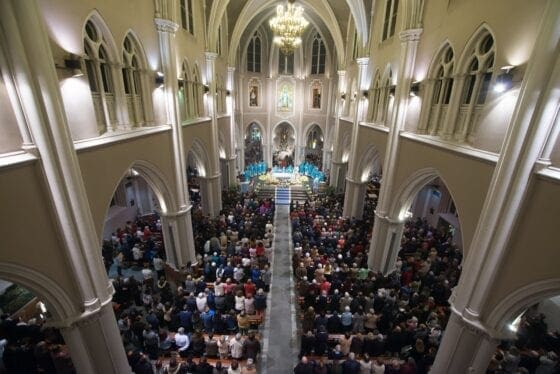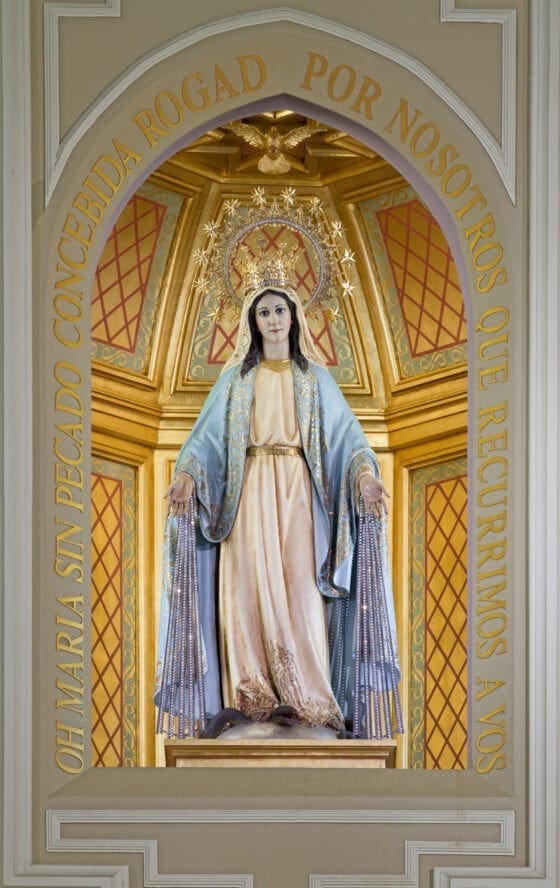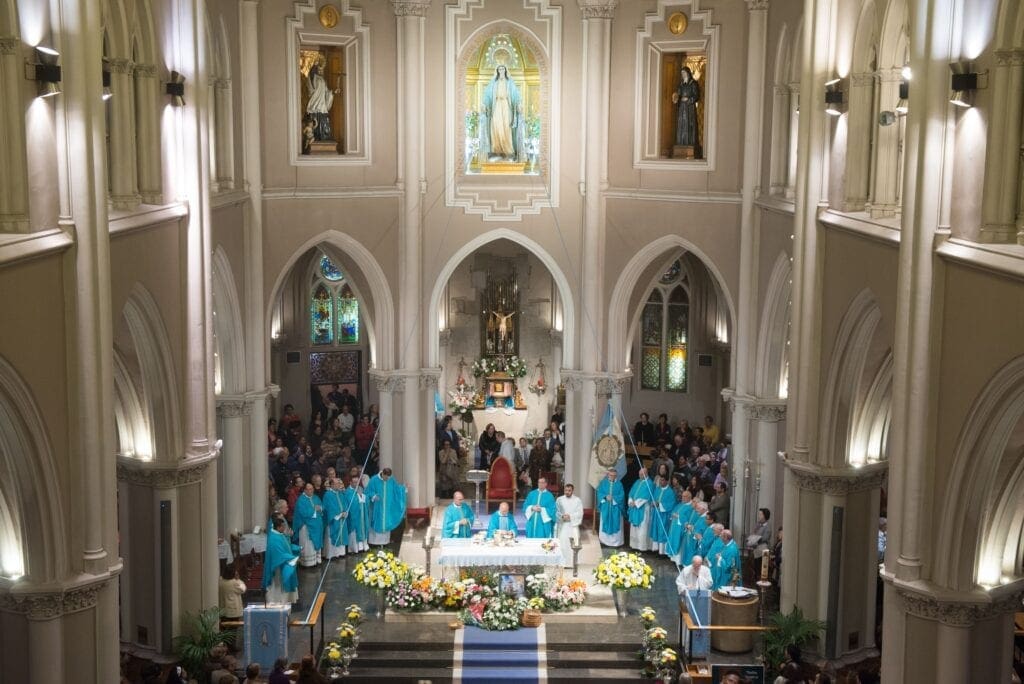As a small tribute to this church and to the Community that celebrates the faith there, we offer some historical and artistic information about the Basilica of Our Lady of the Miraculous Medal and Saint Vincent de Paul, taken from the work of Father Fernando Espiago, “The Basilica of Our Lady of the Miraculous Medal. 100 years in Madrid 1904-2004.”
A CHURCH DEDICATED TO SAINT VINCENT DE PAUL
 Once the house of García de Paredes, 45, was completed, the Community of Vincentian Missionaries, growing more numerous each day, lacked a church where it could celebrate divine worship. It decided to build a church in honor of Saint Vincent de Paul, its founder. A notable architect, Mr. Juan Bautista Lázaro, was sought, and once the plans were made and approved, the work began.
Once the house of García de Paredes, 45, was completed, the Community of Vincentian Missionaries, growing more numerous each day, lacked a church where it could celebrate divine worship. It decided to build a church in honor of Saint Vincent de Paul, its founder. A notable architect, Mr. Juan Bautista Lázaro, was sought, and once the plans were made and approved, the work began.
On 29 April 1900, the land to the right of the new house, between the streets of García de Paredes and the present Fernández de la Hoz, in the heart of the Chamberí neighborhood, was blessed. On 29 March 1901, the then bishop of Madrid, Don José María de Cos, laid the first stone. The construction work lasted four years. On 23 June 1904, the Papal Nuncio, Archbishop Aristide Rinaldini solemnly consecrated and inaugurated the church.
Its architect described it this way: “It is of neo-Gothic style. The exterior architecture is markedly Mudejar, enhanced in brick to harmonize it with the house to which it serves as a complement. The facade is flanked by two towers. In the center of the facade, the church opens to its central nave: the door in a three-point arch and a stonework archivolt. In the second body, there is a large openwork stone rose, crowned by a triangular pediment, and topped by a simple cross.”
The tympanum had a ceramic composition with the Congregation’s coat of arms, the work of the ceramist, Daniel Zuloaga. Not many years ago, it crumbled and could not be restored. A mosaic with the image Our Lady of the Miraculous Medal and at her feet Saint Vincent de Paul and Saint Louise de Marillac was put in its place in 1975. It was the work of the Santa Rufina firm in Madrid.
A beautiful flowery neo-Gothic style gate, recently restored, closes the access to the church. The square towers, up to the height of the beginning of the central pediment, change to octagonal. Its walls are cut by windows, constituting a lantern adorned with gables and pinnacles with pyramidal spires. In one of them is the bell tower and in the other the clock, with spheres in both towers.
DESCRIPTION OF THE CHURCH
 The new church covers an area of 900 square meters, 40 meters long and 24 meters wide. Its arrangement is rectangular, the polygonal head finished. It is divided into three naves with the central area and height higher than the lateral ones and the division is made up of twelve columns, a number symbolic of the Twelve Apostles. The lower naves go around the higher one, constituting the aisle, where in the beginning the seating was located, nearly 300 seats that the needs of the numerous community required.
The new church covers an area of 900 square meters, 40 meters long and 24 meters wide. Its arrangement is rectangular, the polygonal head finished. It is divided into three naves with the central area and height higher than the lateral ones and the division is made up of twelve columns, a number symbolic of the Twelve Apostles. The lower naves go around the higher one, constituting the aisle, where in the beginning the seating was located, nearly 300 seats that the needs of the numerous community required.
Over the years, the church has undergone various transformations, influenced by the tastes of the time, by the war of 1936 – in which everything was destroyed (leaving only the walls of the building and, fortunately, the stained glass windows, for the church was used as movie theater) –, and the Second Vatican Council’s norms for the adaptation of the Liturgy.
After the war, the distinguished Father Antonio Serra, rector of the Basilica since 1926, began the painful work of restoration, putting all his enthusiasm into it, with a very post-war taste and rather poor means, until the new and latest reforms according to the Second Vatican Council’s norms on the Sacred Liturgy were promulgated.
The reform was carried out by Barcelona’s Raventós firm, after several consultations approved by the Archbishop of Madrid’s Liturgy Commission. These reforms began in September 1966 and lasted until 14 March 1967, when it was reopened for worship in a solemn celebration presided over by the Archbishop of Madrid, Don Casimiro Morcillo.
While the works lasted, worship took place in the parish hall, appropriately prepared. The remodeling kept the neo-Gothic style line, trying to harmonize it with the newly introduced lines. It was equipped with a new heating system and air-conditioning for the summer, a chapel for confessionals, and a new chapel in the nave as a place for prayer and small group celebrations.
INTERIOR OF THE CHURCH
 Entering to the right is the Sacred Heart chapel, with a beautiful carving, from the end of the last century that came from the collapsed church of San Francisco, Paredes de Nava (Palencia). The chapel has two simple stained glass windows and a beautiful grill, from the beginning of the construction of the church. The chapel was dedicated as a baptistery until the baptismal font was placed in the main altar’s chancel in 1974.
Entering to the right is the Sacred Heart chapel, with a beautiful carving, from the end of the last century that came from the collapsed church of San Francisco, Paredes de Nava (Palencia). The chapel has two simple stained glass windows and a beautiful grill, from the beginning of the construction of the church. The chapel was dedicated as a baptistery until the baptismal font was placed in the main altar’s chancel in 1974.
On the holy water fonts, made of Colmenar stone, are two plaques: one recalls that the church is a Basilica and the other, the coat of arms of the reigning Pope.
In the right-nave’s arch, next to the penitential-chapel entrance, was placed, in 1967, as an altarpiece, the entire Way to the Cross, beginning with the Prayer in the Garden and ending with the Lord’s Resurrection, work of the Raventós firm in that same year.
In addition to this Passion altarpiece, there is the traditional Way of the Cross for the pious exercise, in metal plates, work of the Granda firm.
In the fourth arcade of the nave, on a simple shelf, is the image of Saint Joseph, a carving from the end of the last century, which, like that of the Sacred Heart, came from Paredes de Nava.
THE CHURCH OF SAINT VINCENT DE PAUL IS DECLARED A MINOR BASILICA
The church, begun in 1900, was inaugurated in 1904 and the splendor of its worship grew since then. The  associations of Our Lady of the Miraculous Medal attracted many faithful, to the point that the church began to be called “Our Lady of the Miraculous Medal.” Even in the provinces, the church was spoken of as The NationalShrine of Our Lady of the Miraculous Medal.
associations of Our Lady of the Miraculous Medal attracted many faithful, to the point that the church began to be called “Our Lady of the Miraculous Medal.” Even in the provinces, the church was spoken of as The NationalShrine of Our Lady of the Miraculous Medal.
In 1923, a pilgrimage to Rome was organized. The march was presided over by Cardinal Segura, then Bishop of Coria, who was later renamed the “Cardinal of the Medal.” Pope Pius XI was asked to give the title of Minor Basilica to the Church of Saint Vincent de Paul.
On 23 July 1923, the Pope published the bull granting the title of Minor Basilica. Pius XI’s Brief, Congregationis Missionis filled everyone with joy.
The title of Basilica had been achieved thanks to the Miraculous Medal Associations. From there, the name of Our Lady of the Miraculous Medal Basilica emerged in popular language. The document, published in the Acta Apostolicae Sedis, and of which there is an authentic copy in the Basilica, is signed by Cardinal Gasparri, Secretary of State. The official name is Basilica of Saint Vincent de Paul.
FROM THE BASILICA OF SAINT VINCENT DE PAUL TO THE MIRACULOUS MEDAL PARISH
The Vincentian Missionaries dedicated this church to Saint Vincent de Paul, as the stained glass windows with passages from his life, the rose window, etc. testify. For many years, the high altar had a large and beautiful image of Saint Vincent over it. The title of Basilica was directed toward the Church of Saint Vincent de Paul, where the Associations of Our Lady of the Miraculous Medal, widely spread throughout Spain, already had their headquarters. When a new altarpiece was built in 1925, the image of Our Lady of the Miraculous Medal occupied the center and that of Saint Vincent the altarpiece’s cornice.
In 1930, on the occasion of the centennial of the Apparitions of the Virgin to Saint Catherine Labouré, there was a great devotional movement toward this title of the Virgin and the people of Madrid began to call this church “Our Lady of the Miraculous Medal.” When in 1965 the Bishop of Madrid erected the parish in this Basilica, he called it simply: Our Lady of the Miraculous Medal Parish, leaving the pontifical titles in the name of Saint Vincent de Paul and the diocesan titles in the name of Our Lady of the Miraculous Medal.
The first pastor, Father Primitivo Gonzalo, asked the Congregation of Divine Worship for an agreement and, in a decree of 29 December 1967, this Congregation granted the Basilica to be called Our Lady of the Miraculous Medal and Saint Vincent of Paul.
Father Fernando Espiago, “The Basilica of Our Lady of the Miraculous Medal


